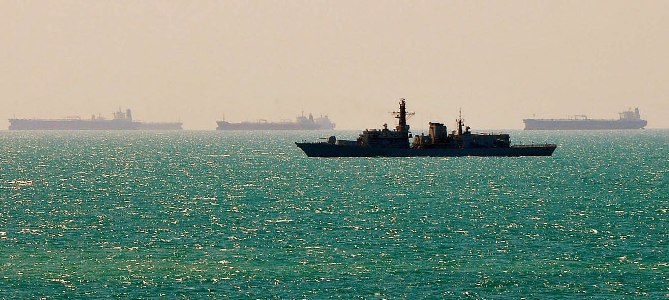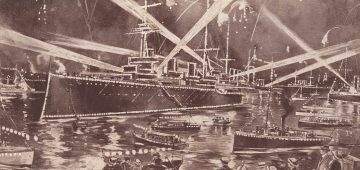Odin’s Eye

The announcement that BAE Systems is being awarded a contract to construct three new Offshore Patrol Vessels (OPVs) for the Royal Navy seems to have caught many by surprise.
The main justification for the ships is that they will provide work for Scottish shipyards between completion of the Queen Elizabeth Class aircraft carriers in the latter half of this decade and commencement of the Global Combat Ship (Type 26) programme.
The latter has, by implication, slipped beyond 2016 to the end of the decade. The OPV order is necessary to maintain the required shipbuilding skills in the United Kingdom. Eyebrows may be raised at the revelation that, under a Terms of Business Agreement signed by BAES with the previous (Labour) administration in 2009, the Ministry of Defence (MoD) would be liable to pay the costs of maintaining these skills whether or not any shipbuilding was taking place at UK yards.
Says the MoD: ‘Building Offshore Patrol Vessels means not only are staff at BAE Systems able to continue to work and maintain their skills, but the Royal Navy benefits from three new ships and the taxpayer gets much better value for money.’
The behind-the-scenes picture is likely to be more complex. The Treasury and other parts of government allegedly still see shipbuilding as a legacy industry and a centre of Trades Union power. BAE is strongly rumoured to want to get out of shipbuilding altogether, but as a counter to such claims it is worth noting that it does have thriving global warship building interests. The Type 26 contract is surely not one it can abandon? And BAE Systems is also the UK’s primary submarine building with an on-going project to construct a new generation of ballistic missile boats (SSBNs) for the Royal Navy.
The Royal Navy may not benefit from the three stopgap ships at all if, under one scenario, the Scots vote ‘yes’ at a referendum and the vessels are given to Scotland to form the nucleus of an independent Scottish Navy.
And, so far, no official statement has mentioned the cost of the new ships, so how is anyone to judge whether they are ‘better value for money’. Better than what?
The ships themselves are reportedly going to be built along the lines of improved River Class OPVs. The Royal Navy’s OPVs have grown by about 200 tons per class in the 30 years since the Island Class of 1976. The new ships will allegedly have a flight-deck large enough to take the Merlin helicopter, so let us say they will be ships of about 2,000 tons. What will their armament consist of? Neither the Island Class, Castle Class nor the River Class has been armed with anything more than a 40mm gun.
Defence Secretary Philip Hammond says of the contract that it “will provide the Royal Navy with three brand new maritime patrol vessels with a wide range of capabilities, which will support our national interests and those of our Overseas Territories.”

Yet what precisely the role of the new ships will be is an enigma. Back to the official-speak: “The ships are expected to replace the current, smaller River Class vessels, HM Ships Tyne, Severn and Mersey which have been policing the UK’s waters since 2003.” But the oldest River Class OPV is barely ten years old, and there are no rumours that these ships have been exceptionally hard-worked or have an unusually short lifespan.
Rather, as the MoD’s official statement indicates, with delivery of the first new ship due in 2017, a final decision on role will not be taken until the Strategic Defence and Security Review due in 2015.
Philip Hammond is correct when he says: “This is an investment not only in three ships but in this country’s warship building industry. It prevents workers standing idle and sustains the vital skills needed to build the planned Type 26 frigate in the future.”
Of course, the new ships are very welcome. They ought to help to fill a yawning gap in the Navy’s order of battle and will be key to training a new generation of Commanding Officers, rather than expect them to learn key ship command lessons on the bridge of a billion pound Daring Class (Type 45) destroyer.
As Alastair Wilson has pointed out in his recently published ‘Biographical Dictionary of the 20th Century Royal Navy’, few admirals of the last century reached flag rank without incurring Their Lordships’ displeasure: That is, they had the chance to make mistakes and to learn from them. They also, most of them, held a command in every rank from Lieutenant onwards. Only this wealth of experience can breed confident, independently minded risk-takers.
Better to learn in an OPV than a Type 45. What the nation, and the Navy, needs is more ships anyway. The RN of today is way too small, its withered critical mass not enough to meet all the many missions the government expect of it. Also needed are replacements for the Hunt Class and the Sandown Class mine-hunters and in sufficient numbers to protect Britain’s ports and to also give young COs early command experience.
But the whole problem needs to be thought through logically and rationally. Fudges like the latest order for three OPVs should be rejected and a proper expansion plan put in place. Realising that the RN needs building up when a crisis hits is too late – the ships and people take decades to create; doing it on the fly simply will not do.
Pictured above:
A British frigate on patrol East of Suez. Will the three new patrol ships be expected to take on such duties?

Photo: US Navy.






Comments
Sorry, comments are closed for this item